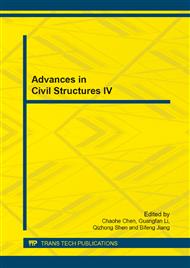p.359
p.369
p.374
p.378
p.384
p.389
p.396
p.402
p.407
Mechanical Behavior Experimental Study on Lattice Wind Turbine Tower KT-Type Joints of Concrete-Filled Steel Tubular
Abstract:
The mechanical behavior of joints on lattice wind turbine tower of concrete-filled steel tubular(CFST) is very complex, the safety and reliability of joints is very important for the whole structure. To better understand the mechanical properties of the joints, we design a static loading test of 3 KT-type CFST joints. According to the test, we make analysis about the failure progress, equivalent stress of joint intersection and the relation of load-defomation. The results showed that due to the presence of concrete, the failure mode of CFST joints is web members failed. The failure characteristic of overlap joints is the instability of compression web member while the gap joints are the weld tear of tensile web member. With the increase of the overlap ratio, the distribution of the equivalent stress is more uniform. The high stress area is in the gap and the tower wall which between the crown point and saddle point in tensile side.
Info:
Periodical:
Pages:
384-388
Citation:
Online since:
July 2014
Authors:
Keywords:
Price:
Сopyright:
© 2014 Trans Tech Publications Ltd. All Rights Reserved
Share:
Citation:


